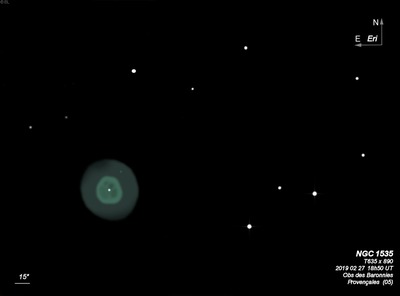
13x80mm finder (1/15/07): fairly bright stellar object at 13x in my 80mm finder and very easy to identify with blinking. Appears as a soft bluish star at 25x and definitely non-stellar at 32x and 54x.
William Herschel discovered NGC 1535 = H IV-26 = h2618 on 1 Feb 1785 (sweep 364) and recorded "a very curious planetary, vB of a uniform brightness all but the edges which are ill defined; about half a minute in diam. With 240 proportionally magnified, perfectly R or perhaps a little elliptical." On a second observation he called it resolvable on the borders, and probably a very compressed cluster of stars at an immense distance. From the Cape of Good Hope, JH recorded "B; S; R; first pretty suddenly, then very gradually brighter in the middle; 20" across. A mottled disc, but so hazy at the borders that I have no doubt of its being a very distant and highly compressed globular cluster. It is not a planetary nebula, though a near approach to one: does not bear magnifying. A power of 320 is of no use. A very remarkable and interesting object." Possibly irregularities in the rim influenced JH to believe it was a GC.
William Lassell observed NGC 1535 on 7 Jan 1853 with his 24-inch equatorial reflector from Malta and commented, "the most interesting and extraordinary object of the kind I have ever seen. A bright well-defined star, perhaps 11th magnitude, right in the centre of a circular nebula, whose edge was the brightest part; and this nebula again placed upon a larger and fainter, concentric and equally symmetrical." His sketch was published in his 1854 MRAS paper (figure 4) on observations from Malta. He sketched it again in 1862 with his 48-inch and wrote, "An extraordinary and beautiful Planetary Nebula powers 760 and 1060. The circumferential nebula fades away at its upper margin and the lowe and opposite part of the circumference is less strongly defined than the preceding and following sides. Moreover, the nucleus does not seem stellar, but a small patch of bright light."
Ralph Copeland, made a detailed observation using Lord Rosse's 72" on 19 Dec 1873: "blue planetary nebula. A small stellar nucleus with a bright atmosphere surrounded by a fainter one [double-shell structure]. There is a very small vacuity close to and sf the nucleus - power 414. Outside diam np and sf = 45.1"; diameter of bright atmosphere = 18.4". With power 625 the nucleus seems quite granular and surrounded by a narrow dark ring extending quite round. Position of two of the most conspicuous central granules = 81.2?."
Sherburne Wesley Burnham, observing with the Lick 36-inch refractor, commented "besides the central star, there are other fainter stars within the nebula. The most prominent of these is near the northern edge of the circular disc... The 14.5m star does not seem to have been seen by other observers [Lassell noted a faint star just inside its preceding edge]." Burnham measured the position of this star at 16" in PA 324? (NW) of the central star.
200/250mm - 8" bright, greenish, fairly small, round.
300/350mm - 13" (12/22/84): at 360x the central star visible surrounded by two shells. The bright inner shell has a small dark annulus surrounding the central star and the outer envelope is fainter and more diffuse.
400/500mm - 17.5" (12/30/99): this planetary has beautiful, bluish double-shell structure which was very evident at 100x surrounding a bright central star. The view at 380x and 500x was superb in good seeing. The double shell envelope was very prominent with a bright inner ring, ~20" diameter, with a fairly sharp edge embedded in a fainter roundish halo roughly doubling the diameter. The inner shell was irregularly darker surrounding the central star.
17.5" (2/8/91): very bright, fairly small, high surface brightness, mag 12.5 central star visible, blue color. This planetary has a double shell structure with inner shell slightly elongated and a faint rounder outer shell. Small dark gaps are visible around the central star.
600/800mm - 24" (11/24/14): I didn't take notes, but at 500x a mag 14.5-15 star was faintly visible near the northwest edge of the outer shell [16" from center].
900/1200mm - 48" (11/1/13): at 813x, this gorgeous planetary displayed an extremely bright, green double-shell structure. The 20" diameter inner ring was quite striking with slight irregularities in thickness and brightness and a very slight elongation. The darker interior of the inner ring was mottled with subtle darker and brighter patches around the mag 12.5 central star. The outer shell doubled the diameter and was slightly elongated ~N-S, 40"x35", with a mag 14.5-15 star superimposed on the NW side [16" from the central star]. With extended viewing there appeared to be subtle variations in brightness, almost like radial striations in the outer and inner shell. (Similar view on 10/23/14).
Notes by Steve Gottlieb